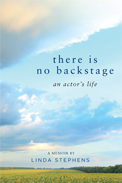
 |
A singer from early childhood, Stephens found her true vocation in college while performing as Eliza Doolittle in My Fair Lady. After marrying upcoming playwright and actor Larry Shue, her life became one of constant travel, performing in dozens of America’s large city-based theaters. Preparation for performances generally began in the late afternoon, with late-night carousing with one’s co-workers as a ”reward” after the applause faded. Meetings with some of the greats—Tennessee Williams, Stephen Sondheim, Arthur Miller—are woven into her recollections. Her notable roles ranged from Hamlet’s Gertrude to Blanche Dubois in A Streetcar Named Desire. Such was Stephen’s dedication that once, having injured her foot and unable to act in a production of Dracula, she worked anyway behind the scenery, using ropes to send a bat sweeping and hovering over the actors. A deep lesson absorbed over her lengthy career is that an actor gradually becomes the character portrayed and must project that transformation to the audience, even in settings outside the theater.
Though she modestly states that readers may not have heard of her, Stephens performed in many well-attended venues, on Broadway and elsewhere, with some of the drama profession’s best-known names and gained many Best Actress awards. In this vibrant memoir, Stephens expertly recounts her five decades onstage and behind the scenes as an actress. Her esteem for her fellow playmakers is evident in the writing. Her well-organized autobiography combines private family events with hundreds of exhilarating and exhausting public performances. Now finding time to remember and record her wide scope of experience, Stephens avows that an actor’s communication with the audience is an enduring gift. Aspiring as well as seasoned actors will doubtless find inspiration from Stephen’s adventures and wish to incorporate her insights into their own practice of the performer’s arts.